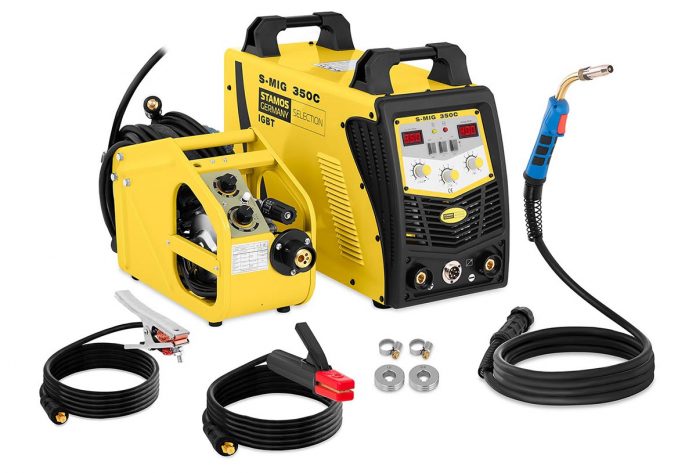
If you are a fan of DIY, you will know that it is a super enriching hobby since, by touching many disciplines, it always keeps you in a continuous learning process. Well, in this article we will deal with one of the aspects that are part of metal carpentry. It is about the union of metals. Specifically, we will talk about the continuous wire welder.
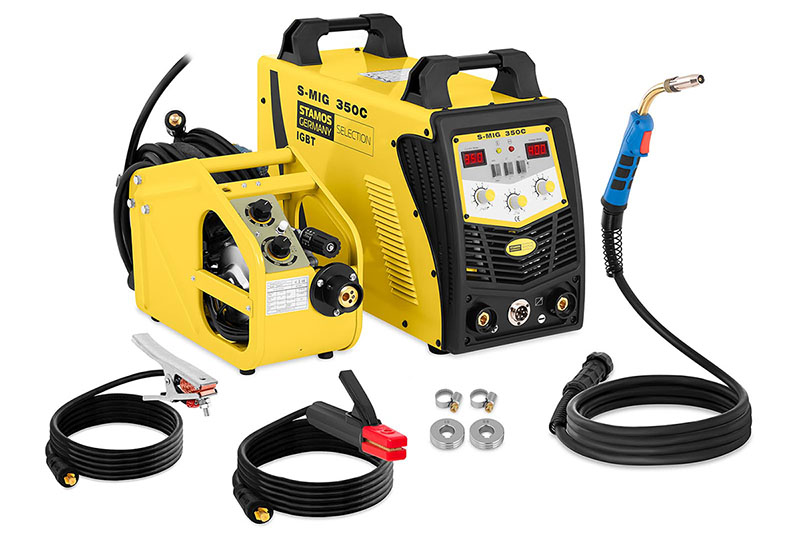
What is wire welding?
We will begin by seeing, very succinctly, what this type of welding consists of.
The continuous wire welder uses a process in which a continuous current of heat is generated, which creates an electric arc between the wire and the metal parts to be joined.
Up to this point, the wire welder works exactly the same as the electrode welder (MMA and TIG), except for the joining material used. In the first continuous wire and in the second electrodes.
The difference lies in a new actor involved in the wire welding process and that is a shielding gas.
The mission of this gas is to protect the welding process by preventing contact with air, stabilizing and homogenizing it.
Two types of shielding gases are commonly used. Inert gas, active gas, even combinations of both. But we will talk about this later.
It is very possible that, at this very moment, you are wondering: If welding with electrodes is somewhat less complex than continuous wire, why not use the first?
Indeed this is perhaps one of its few disadvantages. However, among many other advantages, one of them is its impeccable finishes.
Therefore, if you like perfectionism, like me, it is very possible that you will opt for the continuous wire welder.
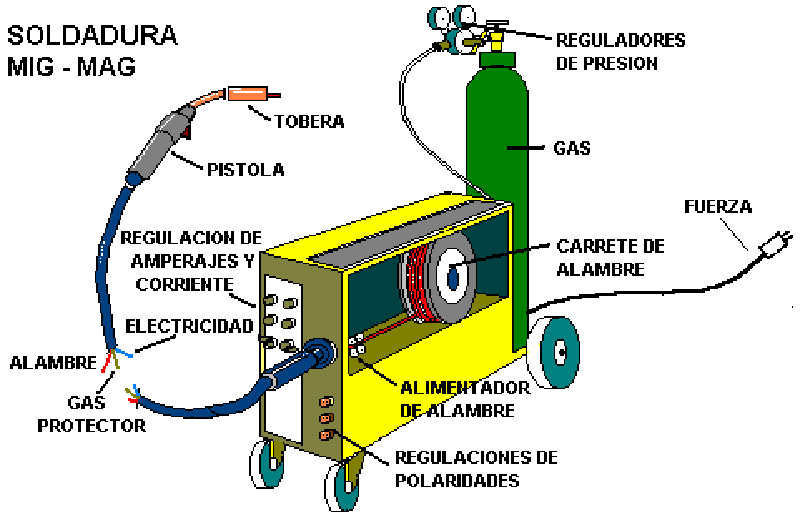
Wire welder components
In the continuous wire welding process, also called MIG / MAG welding, the following components are involved:
MIG/MAG welding
The name of this type of welding has its origin in the type of protective gas used.
MIG refers to inert gas (Metal Inert Gas), and MAG to active gas (Metal Active Gas).
Current generator
The generator, that is, the body of the wire welder. Which manages the regulation of the intensity of the electric arc and the speed of the contribution of the continuous wire, thus optimizing the welding process.
There are two types of generators. Direct current and pulsed current. From a DIY point of view, it is not convenient to go into too many technical aspects. Just indicate that the most suitable generator for DIY enthusiasts is the direct current one, since by keeping the welding voltage constant, it is easier to handle.
Torch with harness
The torch is a handle that manually directs the transmission of the flux material to the welding area. And from here the ignition, the gas outlet and the advance of the welding wire are controlled.
These torches can be self-cooled or water-cooled.
The cables connected to the torch are three. The current conductor, the protective gas nozzle, the exit nozzle and continuous wire guide, and the cooling water (in case of having this device).
Self-cooling torch
These are the most used and the most suitable for DIY, since they are suitable for work with currents below 300 A.
Its self-cooling is carried out by the protection gas it expels.
water cooled torch
On the other hand, there are the water-cooled torches that are indicated for work with currents greater than 300 A, as well as in the case of the use of pulsed currents.
In these cases, the high amounts of thermal energy generated make an extra cooling of the handle necessary.
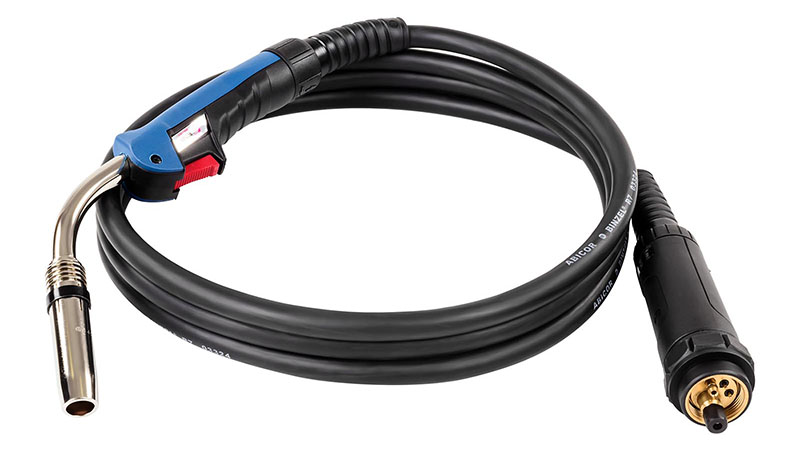
Ground cable clip
The clamp of the ground cable is attached to one of the pieces to be welded, and its mission is to cause the electric arc. In other words, it closes the circuit between the generator, the torch and the material to be joined, thus causing the generation of the heat necessary to melt the wire and carry out the welding correctly.
wire feeder
It is a device, driven by a motor, which is responsible for unwinding the coil of wire by means of rollers, taking it to the torch nozzle. And, from the latter, the speed of supply of the continuous thread is controlled.
There are devices that have four rollers and others with two. Those of four guarantee a greater stability in the speed of exit of the thread. Therefore, they are the most suitable for DIY enthusiasts as they have, a priori, less practice and ease.
gas bottle
The protective gas cylinder has a pressure gauge that indicates the amount of gas that remains inside, along with an electrovalve controlled by the knob located on the handle-torch.
consumables
We still have to talk about two other components of the wire welder, but we have removed them to another section since they are consumable materials, since it is the material that is directly added to each weld.
continuous thread
Before purchasing a spool of wire, at least the part that can be seen should be checked to make sure that the thickness is homogeneous and that it is well wound, otherwise it could cause instability in the advance of the wire.
The wire is the filler material that joins the materials to be welded. There are two types.
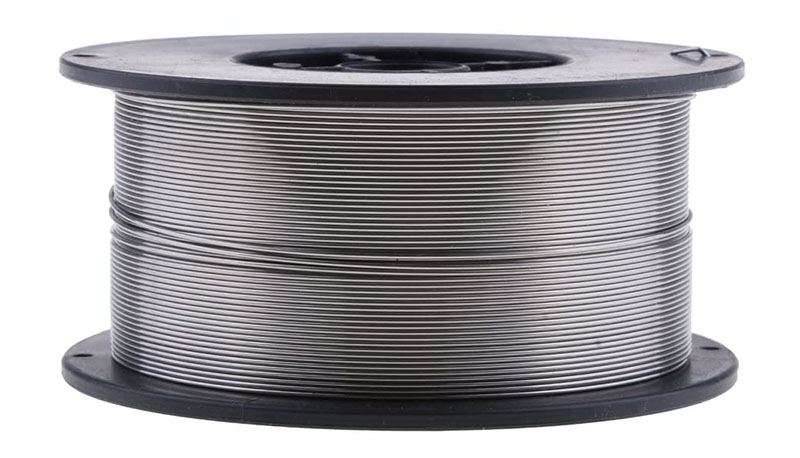
solid thread
On the one hand, solid yarn or solidof which there is little to talk about, except to say that it does not leave any slag in the weld bead and that the thicknesses used mostly are of diameters of 0’6, 0’8, 0’9, 1, 1’2 and 1.6mm.
thread with soul
And on the other, there is the thread with soul or tubularalso called flux type. It is a wire that has an inner core, along the entire length of the thread, composed of protective gas. Therefore, the external supply of gas is not necessary to create the necessary protective atmosphere to carry out the welding.
This is the main reason why it is the most used thread in DIY projects since, for small jobs, gas cylinders can be a nuisance.
This type of wire does generate slag, which is easily removed and exactly the same as in the case of electrode welding (MMA and TIG).
The most used diameters are very similar to those indicated in the solid wire.
shielding gas
In this type of welding, the use of protection gas is an essential requirement. The reason for this is that it is necessary to isolate the welding process from the atmosphere around us.
The two groups of gases used in MIG / MAG welding as protection are inert and active.
inert gases
Within this category is Argon (Ar) and Helium (He).
The Argon provides easy striking as well as good arc stability. It is extracted from the air. And it’s suitable for virtually any type of welding job.
Instead, obtaining the Helium it is more complex and expensive, since it is extracted from the subsoil.
It provides a lower stability of the arc when compared to argon, however it has a greater penetration in the material to be welded. Therefore, it is especially suitable, among other uses, for welding large thicknesses.
active gases
The active gases are Oxygen (O), Carbon Dioxide (CO2) and Hydrogen (H).
The Carbon dioxide, which is present both in the air and underground, has two aspects against it. It forms excessive splashes and makes the electric arc somewhat more unstable.
For this reason, Active Mixtures are used, thus taking advantage of the individual qualities of the different types of gas. Some of these mixtures are Argon/Oxygen/Carbon Dioxide, Argon/Oxygen, …
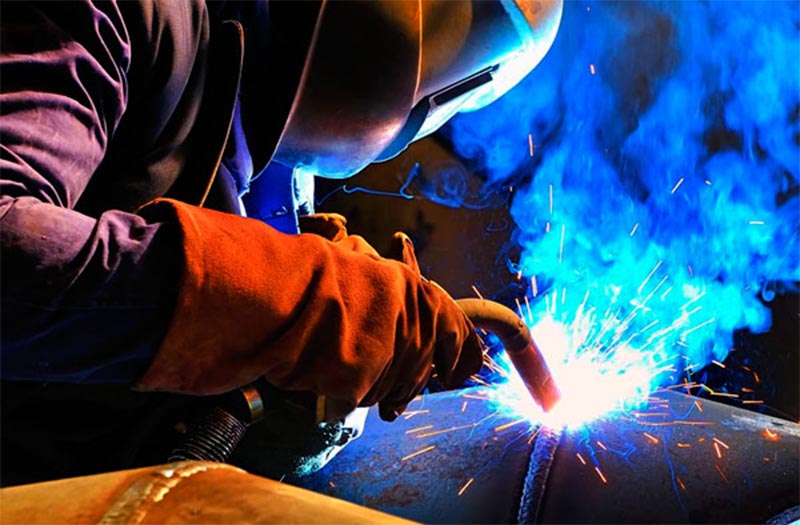
Advantages of the wire welder
Once we have seen what the wire welder is and what MIG / MAG welding consists of, we will see its advantages.
- Allows welding in any position.
- It produces few splashes, reducing the subsequent work of deburring them.
- It emits very little polluting and toxic gases, unlike welding with electrodes (MMA and TIG)
- Ability to perform welds on materials of virtually any thickness.
- It performs quality welds and great aesthetics. Ideal for joints that will be visible.
- Capable of making joints in both ferrous and non-ferrous metals.
- It has great autonomy and precision.
- It is highly productive by having a higher welding speed, and by eliminating downtime when changing electrodes. Although this aspect may not have greater relevance in the field of DIY.
Conclusions
To close this article we will see the conclusions that, I want to clarify, are my personal appreciation based on my experience for many years as a DIY enthusiast.
Regardless of the use, more or less intensive, that you are going to give your welder, if you like a job well done, the ideal option is the wire welder instead of the traditional electrode welder.
Starting from this base, if you are going to carry out large projects or you are going to weld more or less often, choose to take full advantage of it and try the protective gases that we have seen.
On the other hand, if you are only going to use it from time to time, do not complicate yourself and opt for the fastest and simplest way: use the thread with soul.
.
If you want to provide any information of interest in this regard or clarify any point, we would be delighted if you could leave us a comment.
.



